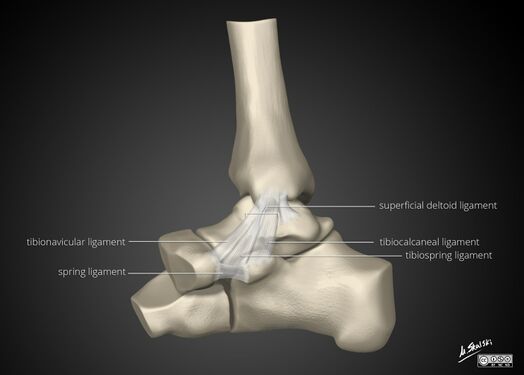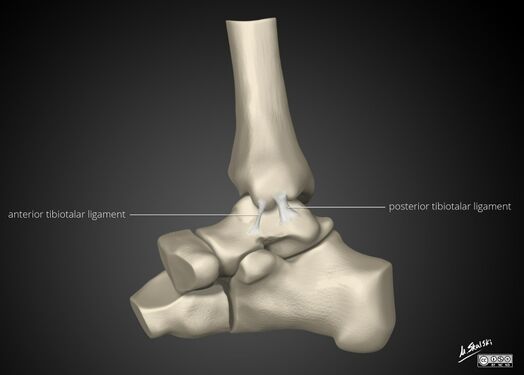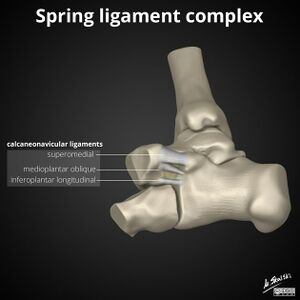Ligaments of the Foot and Ankle
The ligaments that surround the ankle act to limit plantarflexion and dorsiflexion, anterior and posterior movement of the foot, tilting of the talus, and inversion and eversion. Each of the different lateral ligaments have different roles in ankle stabilisation that depends on the position of the foot. Ankle stability depends on ligament orientation, loading type, and ankle position at the point of stress. The lateral ankle is more susceptible to injury.[1]
Overview
| Ligament | Insertion | Action |
|---|---|---|
| Anterior talofibular | Lateral malleolus TO neck of talus | Limits anterior displacement of foot or talar |
| Anterior talotibial | Anterior margin of tibia TO front margin on talus | Limits plantarflexion and abduction of foot |
| Calcaneocuboid | Calcaneus TO cuboid on dorsal surface | Limits inversion of foot |
| Calcaneofibular | Lateral malleolus TO tubercle on outer calcaneus | Resists backward displacement of foot; resists inversion |
| Deltoid | Medial malleolus TO talus, navicular, calcaneus | Resists valgus forces to ankle; limits plantarflexion, dorsiflexion, eversion, abduction of foot |
| Dorsal (tarsometatarsal) | Tarsals TO metatarsals | Supports arch; maintains relationship between tarsals and metatarsal |
| Dorsal calcaneocuboid | Calcaneus TO cuboid on dorsal side | Limits inversion |
| Dorsal talonavicular | Neck of talus TO superior surface of navicular | Supports talonavicular joint; limits inversion |
| Interosseous (intertarsal) | Connects adjacent tarsals | Supports arch of foot, intertarsal joints |
| Interosseous (talocalcaneal) | Undersurface of talus TO upper surface of calcaneus | Limits pronation, supination, abduction, adduction, dorsiflexion, plantarflexion |
| Plantar calcaneocuboid | Undersurface of calcaneus TO undersurface of cuboid | Supports arch |
| Plantar calcaneonavicular (spring) | Anterior margin of calcaneus TO undersurface on navicular | Supports arch; limits abduction |
| Posterior talofibular | Inner, back lateral malleolus TO posterior surface of talus | Limits plantarflexion, dorsiflexion, inversion; supports lateral ankle |
| Posterior talotibial | Tibial TO talus behind articulating facet | Limits planatarflexion; supports medial ankle |
| Talocalcaneal | Connecting anterior/posterior, medial, lateral talus TO calcaneus | Supports subtalar joint |
Deltoid Ligament
Spring Ligament
The spring (plantar calcaneonavicular) ligament complex is a group of ligaments that connect the calcaneum and navicular and support the talus.[2]
The ligaments include:
- superomedial ligament
- forms a sling, suspending/articulating against the head of the talus
- origin from anterior sustentaculum tali with a wide insertion onto the navicular
- merges with the inferior aspect of the tibial spring ligament (a portion of the superficial deltoid ligament), as best appreciated on coronal views
- strongest and most important longitudinal arch stabiliser; also most commonly torn/repaired
- medioplantar oblique ligament
- also known as the lateral calcaneonavicular ligament
- inferoplantar longitudinal ligament
- also known as the intermedial calcaneonavicular ligament
- minor role in stabilising hindfoot and longitudinal arch
These ligaments act as the primary static stabilisers of the medial arch of the foot and, together with the posterior tibialis tendon (primary dynamic stabiliser), help support normal hindfoot relations. Failure of these stabilisers leads to hindfoot valgus and pes planus (pes planovalgus)
References
- ↑ 1.0 1.1 Hamill, Joseph, Kathleen Knutzen, and Timothy R. Derrick. Biomechanical basis of human movement. Philadelphia: Wolters Kluwer Health, 2015.
- ↑ https://radiopaedia.org/articles/spring-ligament-complex?lang=gb




